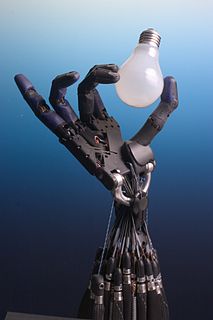
The RoboTuna is a robotic fish project involving a series of robotic fish designed and built by a team of scientists at the Massachusetts Institute of Technology (MIT) in the US.

The RoboTuna is a robotic fish project involving a series of robotic fish designed and built by a team of scientists at the Massachusetts Institute of Technology (MIT) in the US.
The project started in 1993. Their aim was to investigate the possibility of constructing a robotic submarine that could reproduce the way tunas swim and see if they could find a superior system of propulsion for the Autonomous Underwater Vehicles (AUVs). Their experiment was a success as they discovered that their fish was both more maneuverable and used less energy than other robotic submarines. The Science Museum in London, UK has one on display in their geophysics and oceanography section. [1] [2] [3] [4] [5]
While the early results were successful the RoboTuna was not able to replicate the bursts of acceleration that real tuna were able to manage. Researchers tried a genetic algorithm. Early incarnations worked poorly but as the system evolved the RoboTuna's abilities improved. Visualization techniques showed that the system had evolved so that the RoboTuna was taking advantage of vortices that it created. A swish of its tail one way creating a vortex, which was then used by a swish the other way - propelling it off the vortex it had created. This technique not only helps to with normal swimming but explains the impressive standing start speeds of real tuna. [6]
The team involved in the project included: Michael Triantafyllou, David Barrett who built the first RoboTuna (Charlie I) in 1995 for his PhD thesis, and David Beal and Michael Sachinis, who introduced several modifications including a cable-pulley system to produce RoboTuna II. [7]

A fin is a thin component or appendage attached to a larger body or structure. Fins typically function as foils that produce lift or thrust, or provide the ability to steer or stabilize motion while traveling in water, air, or other fluids. Fins are also used to increase surface areas for heat transfer purposes, or simply as ornamentation.

Alvin (DSV-2) is a crewed deep-ocean research submersible owned by the United States Navy and operated by the Woods Hole Oceanographic Institution (WHOI) in Woods Hole, Massachusetts. The vehicle was built by General Mills' Electronics Group in Minneapolis, Minnesota. Named to honor the prime mover and creative inspiration for the vehicle, Allyn Vine, Alvin was commissioned on 5 June 1964. The submersible is launched from the deep submergence support vessel RV Atlantis (AGOR-25), which is also owned by the U.S. Navy and operated by WHOI. The submersible has made more than 5,000 dives, carrying two scientists and a pilot, to observe the lifeforms that must cope with super-pressures and move about in total darkness, as well as exploring the wreck of Titanic. Research conducted by Alvin has been featured in nearly 2,000 scientific papers.

Lego Mindstorms is a hardware and software structure which is produced by Lego for the development of programmable robots based on Lego building blocks. Each version of the system includes a computer Lego brick that controls the system, a set of modular sensors and motors, and Lego parts from the Technic line to create the mechanical systems.

Fish locomotion is the variety of types of animal locomotion used by fish, principally by swimming. This is achieved in different groups of fish by a variety of mechanisms of propulsion in water, most often by wavelike movements of the fish's body and tail, and in various specialised fish by movements of the fins. The major forms of locomotion in fish are anguilliform, in which a wave passes evenly along a long slender body; sub-carangiform, in which the wave increases quickly in amplitude towards the tail; carangiform, in which the wave is concentrated near the tail, which oscillates rapidly; thunniform, rapid swimming with a large powerful crescent-shaped tail; and ostraciiform, with almost no oscillation except of the tail fin. More specialised fish include movement by pectoral fins with a mainly stiff body, opposed sculling with dorsal and anal fins, as in the sunfish; and movement by propagating a wave along the long fins with a motionless body in fish with electric organs, as in the knifefish.

An autonomous underwater vehicle (AUV) is a robot that travels underwater without requiring input from an operator. AUVs constitute part of a larger group of undersea systems known as unmanned underwater vehicles, a classification that includes non-autonomous remotely operated underwater vehicles (ROVs) – controlled and powered from the surface by an operator/pilot via an umbilical or using remote control. In military applications an AUV is more often referred to as an unmanned undersea vehicle (UUV). Underwater gliders are a subclass of AUVs.

The Sea Life London Aquarium is located on the ground floor of County Hall on the South Bank of the River Thames in central London, near the London Eye. It opened in March 1997 as the London Aquarium and hosts about one million visitors each year.
Cognitive robotics is a subfield of robotics concerned with endowing a robot with intelligent behavior by providing it with a processing architecture that will allow it to learn and reason about how to behave in response to complex goals in a complex world. Cognitive robotics may be considered the engineering branch of embodied cognitive science and embodied embedded cognition.
Robot learning is a research field at the intersection of machine learning and robotics. It studies techniques allowing a robot to acquire novel skills or adapt to its environment through learning algorithms. The embodiment of the robot, situated in a physical embedding, provides at the same time specific difficulties and opportunities for guiding the learning process.
Michael Triantafyllou is Professor of Mechanical and Ocean Engineering in the Department of Mechanical Engineering, Director of the Center for Ocean Engineering, Head of the Area of Ocean Science and Engineering, and Director of the Testing Tank and Propeller Tunnel Facilities at the Massachusetts Institute of Technology (MIT). He is best known for his work on underwater robots, based upon and emulating the performance of fish, including the six-foot laboratory robot the RoboTuna, the free-swimming RoboPike (1998), and the RoboTurtle (2005).

Peter Nordin was a Swedish computer scientist, entrepreneur and author who has contributed to artificial intelligence, automatic programming, machine learning, and evolutionary robotics.

RoboJackets is a group of Georgia Tech students, faculty, and alumni that aims to enhance the understanding of the field of robotics and its applications. The team also strives to increase of the number of students exposed to it. The group, located in the Student Competition Center, allows students to engage in a wide range of engineering-related activities, and has members from almost every engineering major of study offered at Georgia Tech. Students work collaboratively in a group environment and have the abilities to pursue projects on their own.
Artificial development, also known as artificial embryogeny or machine intelligence or computational development, is an area of computer science and engineering concerned with computational models motivated by genotype-phenotype mappings in biological systems. Artificial development is often considered a sub-field of evolutionary computation, although the principles of artificial development have also been used within stand-alone computational models.

Robotics is an interdisciplinary field that integrates computer science and engineering. Robotics involves design, construction, operation, and use of robots. The goal of robotics is to design machines that can help and assist humans. Robotics integrates fields of mechanical engineering, electrical engineering, information engineering, mechatronics, electronics, bioengineering, computer engineering, control engineering, software engineering, mathematics, among others.

Aquatic locomotion is biologically propelled motion through a liquid medium. The simplest propulsive systems are composed of cilia and flagella. Swimming has evolved a number of times in a range of organisms including arthropods, fish, molluscs, reptiles, birds, and mammals.
The following outline is provided as an overview of and topical guide to robotics:

Certain species of fish and birds are able to locomote in both air and water, two fluid media with very different properties. A fluid is a particular phase of matter that deforms under shear stresses and includes any type of liquid or gas. Because fluids are easily deformable and move in response to applied forces, efficiently locomoting in a fluid medium presents unique challenges. Specific morphological characteristics are therefore required in animal species that primarily depend on fluidic locomotion. Because the properties of air and water are so different, swimming and flying have very disparate morphological requirements. As a result, despite the large diversity of animals that are capable of flight or swimming, only a limited number of these species have mastered the ability to both fly and swim. These species demonstrate distinct morphological and behavioral tradeoffs associated with transitioning from air to water and water to air.

Ernest Hemingway owned a 38-foot (12 m) fishing boat named Pilar. It was acquired in April 1934 from Wheeler Shipbuilding in Brooklyn, New York, for $7,495. "Pilar" was a nickname for Hemingway's second wife, Pauline, and also the name of the woman leader of the partisan band in his 1940 novel of the Spanish Civil War, For Whom the Bell Tolls. Hemingway regularly fished off the boat in the waters of Key West, Florida, Marquesas Keys, and the Gulf Stream off the Cuban coast. He made three trips with the boat to the Bimini islands wherein his fishing, drinking, and fighting exploits drew much attention and remain part of the history of the islands. In addition to fishing trips on Pilar, Hemingway contributed to scientific research which included collaboration with the Smithsonian Institution. Several of Hemingway's books were influenced by time spent on the boat, most notably, The Old Man and the Sea (1953) and Islands in the Stream (1970). The yacht also inspired the name of Playa Pilar on Cayo Guillermo. A smaller replica of the boat is depicted in the opening and other scenes in the 2012 film Hemingway & Gellhorn.

Fins are distinctive anatomical features composed of bony spines or rays protruding from the body of a fish. They are covered with skin and joined together either in a webbed fashion, as seen in most bony fish, or similar to a flipper, as seen in sharks. Apart from the tail or caudal fin, fish fins have no direct connection with the spine and are supported only by muscles. Their principal function is to help the fish swim.

RoboBee is a tiny robot capable of partially untethered flight, developed by a research robotics team at Harvard University. The culmination of twelve years of research, RoboBee solved two key technical challenges of micro-robotics. Engineers invented a process inspired by pop-up books that allowed them to build on a sub-millimeter scale precisely and efficiently. To achieve flight, they created artificial muscles capable of beating the wings 120 times per second.

A robot fish is a type of bionic robot that has the shape and locomotion of a living fish. Since the Massachusetts Institute of Technology first published research on them in 1989, there have been more than 400 articles published about robot fish. According to these reports, approximately 40 different types of robot fish have been built, with 30 designs having only the capability to flip and drift in water. Most robot fish are designed to emulate living fish which use Body-caudal fin (BCF) propulsion. BCF robot fish can be divided into three categories: Single Joint (SJ), Multi-Joint (MJ), and smart material-based design. The most important parts of researching and developing robot fish are advancing their control and navigation, enabling them to 'communicate' with their environment, making it possible for them to travel along a particular path, and to respond to commands to make their 'fins' flap.